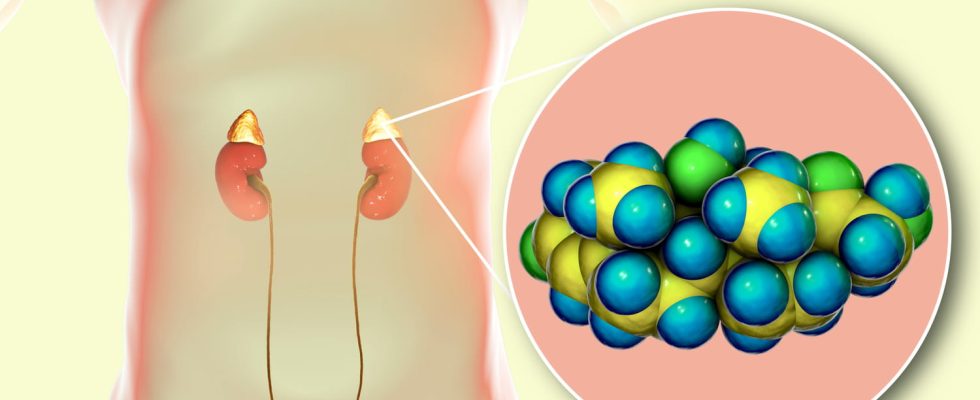Linked to an abnormally high cortisol level, Cushing’s disease causes many symptoms. Cushing’s disease must be distinguished from Cushing’s syndrome. Explanations.
There Cushing’s disease corresponds to a tumor located in the pituitary gland (brain). This tumor will lead to a series of symptoms that characterize what is called the Cushing’s syndrome. The term “syndrome” meaning in medical jargon a set of symptoms characterizing a pathological state. There Cushing’s disease is in nearly three quarters of cases the only cause of the symptoms of Cushing’s syndrome but there are also other causes giving the same syndrome, hence the fact that we can speak of “disease” and “syndrome”. “but you have to tell them apart. There High Authority of Health defined thee Cushing’s syndrome as I’set of clinical manifestations induced by chronic exposure to an endogenous excess of glucocorticoids. Untreated, it induces a excess mortality and significant morbidity, especially cardiovascular. Its diagnosis and treatment remain delicate.
Cushing’s disease is a tumor located in the pituitary gland (brain)which secretes in excess theACTH hormone (Or adrenocorticotropic hormone), which acts directly on the adrenal gland. This tumor will lead to an excess functioning of the adrenal cortex, an area of this gland responsible for the secretion, among other things, of glucocorticoids. “Besides, other causes may cause excessive secretion of cortisol, the main glucocorticoid, says Professor Philippe Touraine. There are non-pituitary tumors secreting large amounts of ACTH (in the lung, thymus, skin, etc.). There are also adrenal tumors that produce this excess cortisol: these are adrenal adenomas or adrenal corticals. These etiological hypotheses should not make us forget that in the majority of cases, when we observe a patient with signs of excessive impregnation of cortisol, it is due to long-term glucocorticoids (medication, editor’s note), as in inflammatory diseases“.
THE specific symptoms Cushing’s syndrome are:
- cutaneous: skin fragility, bruises, stretch marks
- muscle (proximal amyotrophy);
- bony (osteoporosis).
Can also direct the diagnosis towards Cushing’s syndrome:
- A growth slowdown especially if it is associated with weight gain in children.
- A Type 2 diabetes (metabolic syndrome / unbalanced diabetes with no obvious cause)
- a high blood pressure
- behavioral problems.
- osteoporosis with no obvious cause
- adrenal tumor of cortical origin
Note that in Cushing’s disease and paraneoplastic syndrome, a melanoderma, skin that becomes darker, is possible. “Please note that melanoderma is above all a sign of paraneoplastic disease because the levels of ACTH are significantly higher than those observed during Cushing’s disease.nuance the endocrinologist.
In the presence of symptoms evoking Cushing’s disease, you should consult your doctor who will refer you to a specialist, namely a endocrinologist. To confirm the diagnosis, blood test and/or urine analysis aimed at confirming cortisol hypersecretion will be performed. The cause of this hypersecretion will then be sought in order to adapt the treatment.
The diagnosis is made in front of the clinical picture coupled with the practice ofAdditional tests :
- cortisol level test in the blood and/or saliva at several hours of the day and in particular that of midnight is a good marker.
- urinary cortisol level, increased compared to normal.
- ACTH level assay, which allows the etiological orientation; it is increased in the case of Cushing’s disease or paraneoplastic syndrome; it is reduced in tumors of the adrenal gland.
- so-called dynamic tests are also frequently performed, after injection of varying doses of a product called dexamethasone.
- in case of decreased ACTH, imaging of the adrenals will be carried out, in particular a scanner.
- in case of increased ACTH as in Cushing’s disease, a Pituitary MRI allow the study of the pituitary gland.
“The chances of recovery differ depending on the location of the adenoma responsible for Cushing’s disease, says the specialist. When it is clearly visible on the MRI and does not extend into an area not accessible to the surgeon, the chances of recovery are 70 to 80%. When the pituitary adenoma is poorly identified on MRI, pituitary surgery can cure the patient in less than 70% of cases. On the other hand, if the pituitary adenoma is very large, surgery can reduce the excess cortisol but not eliminate it.
The treatment for Cushing’s syndrome depends on the cause of the glucocorticoid hypersecretion. Usually, the tumor involved in excess glucocorticoid secretion must be surgically removed.
Cushing’s disease can cause different sequelae:
- Osteoporosis due to overimpregnation with glucocorticoids.
- Psychiatric disorders related to glucocorticoid withdrawal.
- Partial or complete post-surgery pituitary insufficiency.
- High blood pressure.
- Diabetes.
- Menstrual cycle disorders and increased risk of infertility.
- Increased risk of infections.
Untreated, Cushing’s syndrome induces significant excess mortality and morbidity, particularly cardiovascular. “If untreated or partially treated, Cushing’s disease may promote comorbidities (vertebral fractures, cardiovascular, infectious, psychiatric risks) and thus threaten the vital prognosis, confirms Professor Philippe Touraine, in rare cases, Cushing’s disease may be due to adrenocortical tumor, the prognosis of which is often poor. However, in the vast majority of cases, Cushing’s syndrome is associated with benign lesions and can be easily cured“.
Thanks to Professor Philippe Touraine, Head of the Department of Endocrinology and Reproductive Medicine, at the Pitié Salpêtrière Hospital.
